International Marketing: The Importance of Culture in Business
VerifiedAdded on 2022/11/15
|7
|1777
|238
Report
AI Summary
This report examines the critical role of culture in international marketing within the context of increasing globalization. It begins with an executive summary and introduction that defines culture and its elements, highlighting its importance in shaping consumer behavior and marketing strategies. The report discusses various cultural elements, such as language, norms, beliefs, and values, and their positive implications in international marketing. It emphasizes the need for companies to understand and adapt to local cultures to succeed. The report uses academic literature and the example of Coca-Cola to illustrate how cultural sensitivity and adaptation are crucial for effective global marketing. The conclusion reinforces the significant influence of culture on international marketing and the necessity for companies to study local cultures to conduct successful global business activities. References are provided in Chicago Ver 16 format.

International marketing
Paraphrase This Document
Need a fresh take? Get an instant paraphrase of this document with our AI Paraphraser
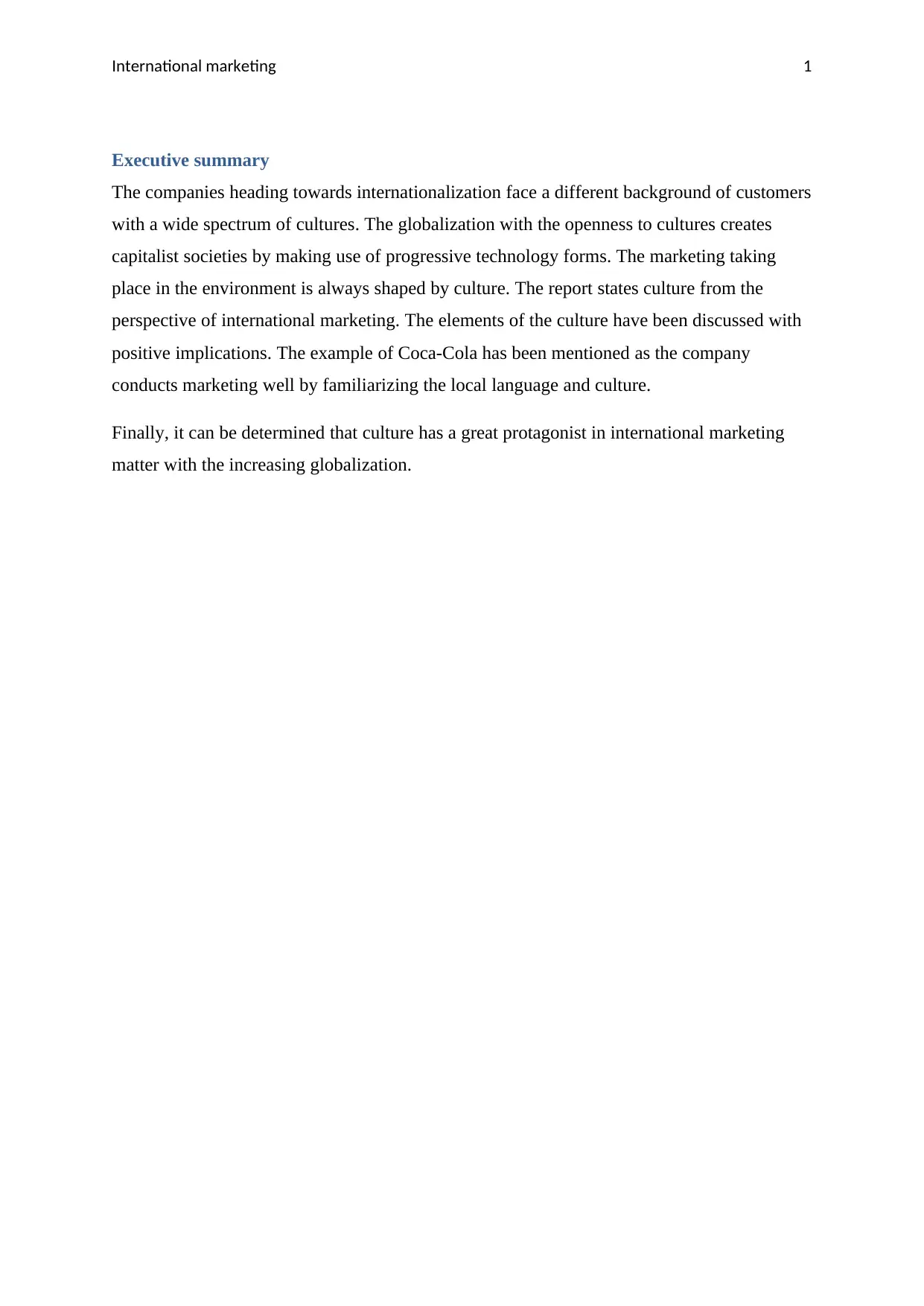
International marketing 1
Executive summary
The companies heading towards internationalization face a different background of customers
with a wide spectrum of cultures. The globalization with the openness to cultures creates
capitalist societies by making use of progressive technology forms. The marketing taking
place in the environment is always shaped by culture. The report states culture from the
perspective of international marketing. The elements of the culture have been discussed with
positive implications. The example of Coca-Cola has been mentioned as the company
conducts marketing well by familiarizing the local language and culture.
Finally, it can be determined that culture has a great protagonist in international marketing
matter with the increasing globalization.
Executive summary
The companies heading towards internationalization face a different background of customers
with a wide spectrum of cultures. The globalization with the openness to cultures creates
capitalist societies by making use of progressive technology forms. The marketing taking
place in the environment is always shaped by culture. The report states culture from the
perspective of international marketing. The elements of the culture have been discussed with
positive implications. The example of Coca-Cola has been mentioned as the company
conducts marketing well by familiarizing the local language and culture.
Finally, it can be determined that culture has a great protagonist in international marketing
matter with the increasing globalization.

International marketing 2
Contents
Executive summary....................................................................................................................1
Introduction................................................................................................................................3
Conclusion..................................................................................................................................5
References..................................................................................................................................6
Contents
Executive summary....................................................................................................................1
Introduction................................................................................................................................3
Conclusion..................................................................................................................................5
References..................................................................................................................................6
⊘ This is a preview!⊘
Do you want full access?
Subscribe today to unlock all pages.

Trusted by 1+ million students worldwide
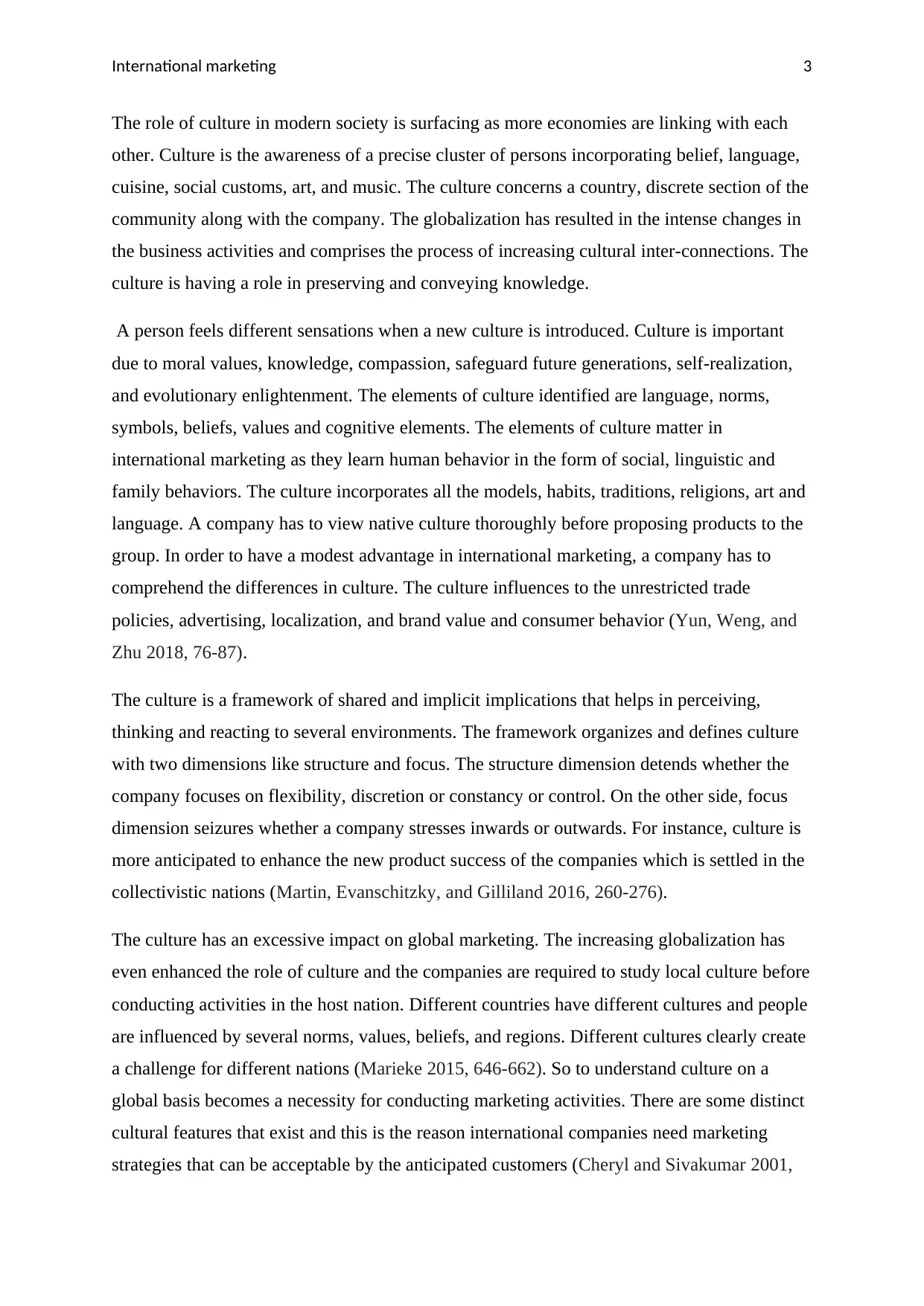
International marketing 3
The role of culture in modern society is surfacing as more economies are linking with each
other. Culture is the awareness of a precise cluster of persons incorporating belief, language,
cuisine, social customs, art, and music. The culture concerns a country, discrete section of the
community along with the company. The globalization has resulted in the intense changes in
the business activities and comprises the process of increasing cultural inter-connections. The
culture is having a role in preserving and conveying knowledge.
A person feels different sensations when a new culture is introduced. Culture is important
due to moral values, knowledge, compassion, safeguard future generations, self-realization,
and evolutionary enlightenment. The elements of culture identified are language, norms,
symbols, beliefs, values and cognitive elements. The elements of culture matter in
international marketing as they learn human behavior in the form of social, linguistic and
family behaviors. The culture incorporates all the models, habits, traditions, religions, art and
language. A company has to view native culture thoroughly before proposing products to the
group. In order to have a modest advantage in international marketing, a company has to
comprehend the differences in culture. The culture influences to the unrestricted trade
policies, advertising, localization, and brand value and consumer behavior (Yun, Weng, and
Zhu 2018, 76-87).
The culture is a framework of shared and implicit implications that helps in perceiving,
thinking and reacting to several environments. The framework organizes and defines culture
with two dimensions like structure and focus. The structure dimension detends whether the
company focuses on flexibility, discretion or constancy or control. On the other side, focus
dimension seizures whether a company stresses inwards or outwards. For instance, culture is
more anticipated to enhance the new product success of the companies which is settled in the
collectivistic nations (Martin, Evanschitzky, and Gilliland 2016, 260-276).
The culture has an excessive impact on global marketing. The increasing globalization has
even enhanced the role of culture and the companies are required to study local culture before
conducting activities in the host nation. Different countries have different cultures and people
are influenced by several norms, values, beliefs, and regions. Different cultures clearly create
a challenge for different nations (Marieke 2015, 646-662). So to understand culture on a
global basis becomes a necessity for conducting marketing activities. There are some distinct
cultural features that exist and this is the reason international companies need marketing
strategies that can be acceptable by the anticipated customers (Cheryl and Sivakumar 2001,
The role of culture in modern society is surfacing as more economies are linking with each
other. Culture is the awareness of a precise cluster of persons incorporating belief, language,
cuisine, social customs, art, and music. The culture concerns a country, discrete section of the
community along with the company. The globalization has resulted in the intense changes in
the business activities and comprises the process of increasing cultural inter-connections. The
culture is having a role in preserving and conveying knowledge.
A person feels different sensations when a new culture is introduced. Culture is important
due to moral values, knowledge, compassion, safeguard future generations, self-realization,
and evolutionary enlightenment. The elements of culture identified are language, norms,
symbols, beliefs, values and cognitive elements. The elements of culture matter in
international marketing as they learn human behavior in the form of social, linguistic and
family behaviors. The culture incorporates all the models, habits, traditions, religions, art and
language. A company has to view native culture thoroughly before proposing products to the
group. In order to have a modest advantage in international marketing, a company has to
comprehend the differences in culture. The culture influences to the unrestricted trade
policies, advertising, localization, and brand value and consumer behavior (Yun, Weng, and
Zhu 2018, 76-87).
The culture is a framework of shared and implicit implications that helps in perceiving,
thinking and reacting to several environments. The framework organizes and defines culture
with two dimensions like structure and focus. The structure dimension detends whether the
company focuses on flexibility, discretion or constancy or control. On the other side, focus
dimension seizures whether a company stresses inwards or outwards. For instance, culture is
more anticipated to enhance the new product success of the companies which is settled in the
collectivistic nations (Martin, Evanschitzky, and Gilliland 2016, 260-276).
The culture has an excessive impact on global marketing. The increasing globalization has
even enhanced the role of culture and the companies are required to study local culture before
conducting activities in the host nation. Different countries have different cultures and people
are influenced by several norms, values, beliefs, and regions. Different cultures clearly create
a challenge for different nations (Marieke 2015, 646-662). So to understand culture on a
global basis becomes a necessity for conducting marketing activities. There are some distinct
cultural features that exist and this is the reason international companies need marketing
strategies that can be acceptable by the anticipated customers (Cheryl and Sivakumar 2001,
Paraphrase This Document
Need a fresh take? Get an instant paraphrase of this document with our AI Paraphraser
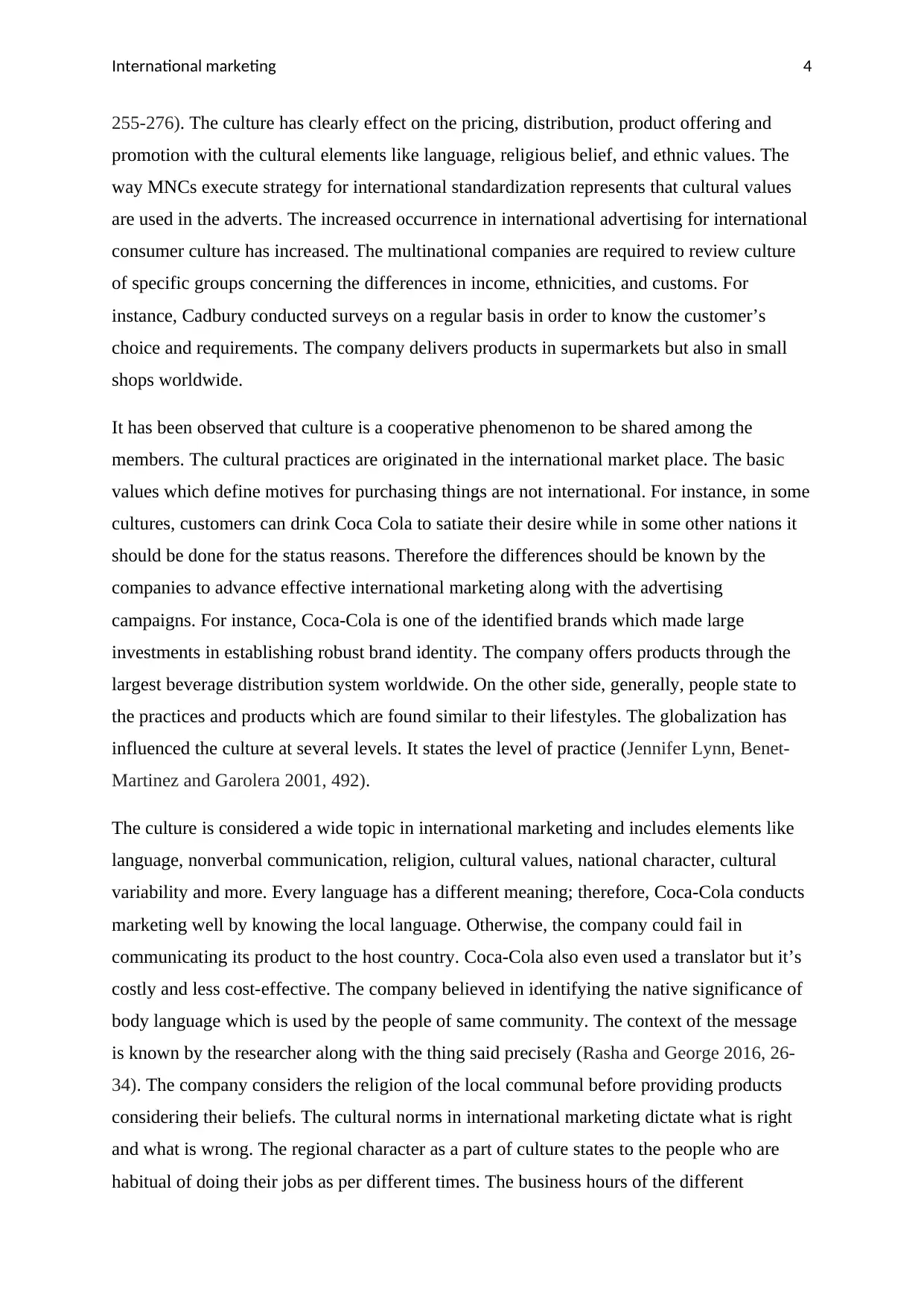
International marketing 4
255-276). The culture has clearly effect on the pricing, distribution, product offering and
promotion with the cultural elements like language, religious belief, and ethnic values. The
way MNCs execute strategy for international standardization represents that cultural values
are used in the adverts. The increased occurrence in international advertising for international
consumer culture has increased. The multinational companies are required to review culture
of specific groups concerning the differences in income, ethnicities, and customs. For
instance, Cadbury conducted surveys on a regular basis in order to know the customer’s
choice and requirements. The company delivers products in supermarkets but also in small
shops worldwide.
It has been observed that culture is a cooperative phenomenon to be shared among the
members. The cultural practices are originated in the international market place. The basic
values which define motives for purchasing things are not international. For instance, in some
cultures, customers can drink Coca Cola to satiate their desire while in some other nations it
should be done for the status reasons. Therefore the differences should be known by the
companies to advance effective international marketing along with the advertising
campaigns. For instance, Coca-Cola is one of the identified brands which made large
investments in establishing robust brand identity. The company offers products through the
largest beverage distribution system worldwide. On the other side, generally, people state to
the practices and products which are found similar to their lifestyles. The globalization has
influenced the culture at several levels. It states the level of practice (Jennifer Lynn, Benet-
Martinez and Garolera 2001, 492).
The culture is considered a wide topic in international marketing and includes elements like
language, nonverbal communication, religion, cultural values, national character, cultural
variability and more. Every language has a different meaning; therefore, Coca-Cola conducts
marketing well by knowing the local language. Otherwise, the company could fail in
communicating its product to the host country. Coca-Cola also even used a translator but it’s
costly and less cost-effective. The company believed in identifying the native significance of
body language which is used by the people of same community. The context of the message
is known by the researcher along with the thing said precisely (Rasha and George 2016, 26-
34). The company considers the religion of the local communal before providing products
considering their beliefs. The cultural norms in international marketing dictate what is right
and what is wrong. The regional character as a part of culture states to the people who are
habitual of doing their jobs as per different times. The business hours of the different
255-276). The culture has clearly effect on the pricing, distribution, product offering and
promotion with the cultural elements like language, religious belief, and ethnic values. The
way MNCs execute strategy for international standardization represents that cultural values
are used in the adverts. The increased occurrence in international advertising for international
consumer culture has increased. The multinational companies are required to review culture
of specific groups concerning the differences in income, ethnicities, and customs. For
instance, Cadbury conducted surveys on a regular basis in order to know the customer’s
choice and requirements. The company delivers products in supermarkets but also in small
shops worldwide.
It has been observed that culture is a cooperative phenomenon to be shared among the
members. The cultural practices are originated in the international market place. The basic
values which define motives for purchasing things are not international. For instance, in some
cultures, customers can drink Coca Cola to satiate their desire while in some other nations it
should be done for the status reasons. Therefore the differences should be known by the
companies to advance effective international marketing along with the advertising
campaigns. For instance, Coca-Cola is one of the identified brands which made large
investments in establishing robust brand identity. The company offers products through the
largest beverage distribution system worldwide. On the other side, generally, people state to
the practices and products which are found similar to their lifestyles. The globalization has
influenced the culture at several levels. It states the level of practice (Jennifer Lynn, Benet-
Martinez and Garolera 2001, 492).
The culture is considered a wide topic in international marketing and includes elements like
language, nonverbal communication, religion, cultural values, national character, cultural
variability and more. Every language has a different meaning; therefore, Coca-Cola conducts
marketing well by knowing the local language. Otherwise, the company could fail in
communicating its product to the host country. Coca-Cola also even used a translator but it’s
costly and less cost-effective. The company believed in identifying the native significance of
body language which is used by the people of same community. The context of the message
is known by the researcher along with the thing said precisely (Rasha and George 2016, 26-
34). The company considers the religion of the local communal before providing products
considering their beliefs. The cultural norms in international marketing dictate what is right
and what is wrong. The regional character as a part of culture states to the people who are
habitual of doing their jobs as per different times. The business hours of the different
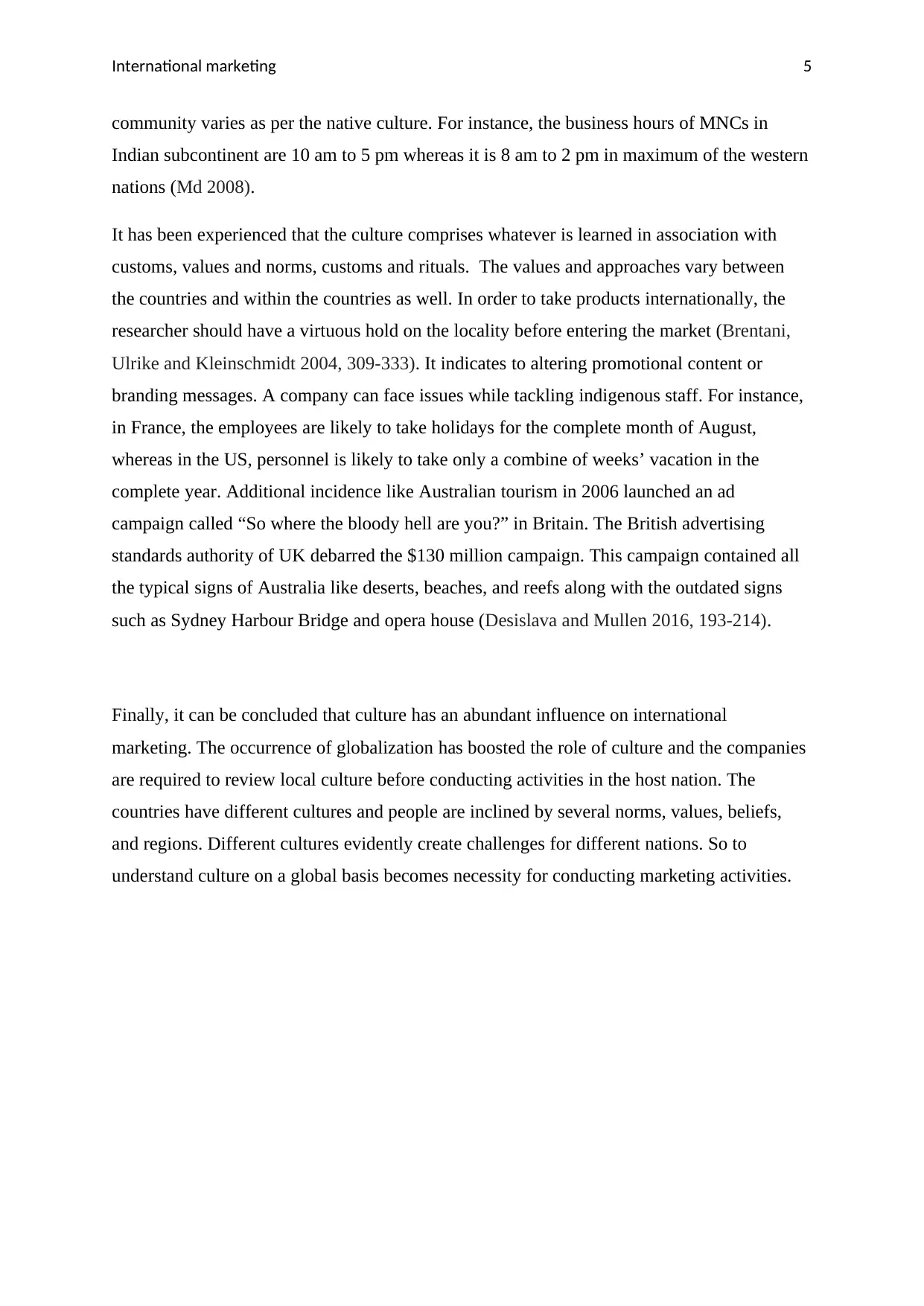
International marketing 5
community varies as per the native culture. For instance, the business hours of MNCs in
Indian subcontinent are 10 am to 5 pm whereas it is 8 am to 2 pm in maximum of the western
nations (Md 2008).
It has been experienced that the culture comprises whatever is learned in association with
customs, values and norms, customs and rituals. The values and approaches vary between
the countries and within the countries as well. In order to take products internationally, the
researcher should have a virtuous hold on the locality before entering the market (Brentani,
Ulrike and Kleinschmidt 2004, 309-333). It indicates to altering promotional content or
branding messages. A company can face issues while tackling indigenous staff. For instance,
in France, the employees are likely to take holidays for the complete month of August,
whereas in the US, personnel is likely to take only a combine of weeks’ vacation in the
complete year. Additional incidence like Australian tourism in 2006 launched an ad
campaign called “So where the bloody hell are you?” in Britain. The British advertising
standards authority of UK debarred the $130 million campaign. This campaign contained all
the typical signs of Australia like deserts, beaches, and reefs along with the outdated signs
such as Sydney Harbour Bridge and opera house (Desislava and Mullen 2016, 193-214).
Finally, it can be concluded that culture has an abundant influence on international
marketing. The occurrence of globalization has boosted the role of culture and the companies
are required to review local culture before conducting activities in the host nation. The
countries have different cultures and people are inclined by several norms, values, beliefs,
and regions. Different cultures evidently create challenges for different nations. So to
understand culture on a global basis becomes necessity for conducting marketing activities.
community varies as per the native culture. For instance, the business hours of MNCs in
Indian subcontinent are 10 am to 5 pm whereas it is 8 am to 2 pm in maximum of the western
nations (Md 2008).
It has been experienced that the culture comprises whatever is learned in association with
customs, values and norms, customs and rituals. The values and approaches vary between
the countries and within the countries as well. In order to take products internationally, the
researcher should have a virtuous hold on the locality before entering the market (Brentani,
Ulrike and Kleinschmidt 2004, 309-333). It indicates to altering promotional content or
branding messages. A company can face issues while tackling indigenous staff. For instance,
in France, the employees are likely to take holidays for the complete month of August,
whereas in the US, personnel is likely to take only a combine of weeks’ vacation in the
complete year. Additional incidence like Australian tourism in 2006 launched an ad
campaign called “So where the bloody hell are you?” in Britain. The British advertising
standards authority of UK debarred the $130 million campaign. This campaign contained all
the typical signs of Australia like deserts, beaches, and reefs along with the outdated signs
such as Sydney Harbour Bridge and opera house (Desislava and Mullen 2016, 193-214).
Finally, it can be concluded that culture has an abundant influence on international
marketing. The occurrence of globalization has boosted the role of culture and the companies
are required to review local culture before conducting activities in the host nation. The
countries have different cultures and people are inclined by several norms, values, beliefs,
and regions. Different cultures evidently create challenges for different nations. So to
understand culture on a global basis becomes necessity for conducting marketing activities.
⊘ This is a preview!⊘
Do you want full access?
Subscribe today to unlock all pages.

Trusted by 1+ million students worldwide
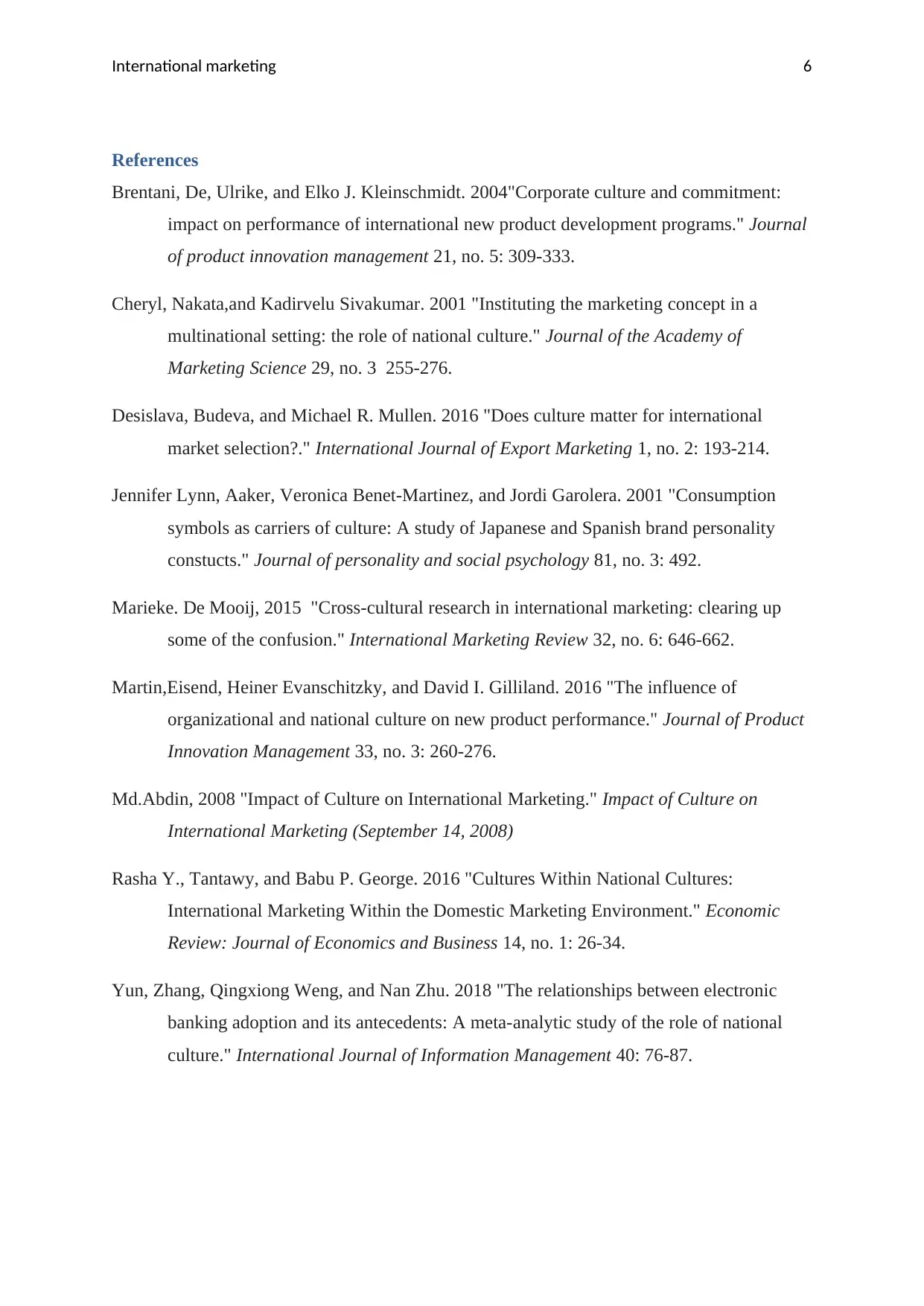
International marketing 6
References
Brentani, De, Ulrike, and Elko J. Kleinschmidt. 2004"Corporate culture and commitment:
impact on performance of international new product development programs." Journal
of product innovation management 21, no. 5: 309-333.
Cheryl, Nakata,and Kadirvelu Sivakumar. 2001 "Instituting the marketing concept in a
multinational setting: the role of national culture." Journal of the Academy of
Marketing Science 29, no. 3 255-276.
Desislava, Budeva, and Michael R. Mullen. 2016 "Does culture matter for international
market selection?." International Journal of Export Marketing 1, no. 2: 193-214.
Jennifer Lynn, Aaker, Veronica Benet-Martinez, and Jordi Garolera. 2001 "Consumption
symbols as carriers of culture: A study of Japanese and Spanish brand personality
constucts." Journal of personality and social psychology 81, no. 3: 492.
Marieke. De Mooij, 2015 "Cross-cultural research in international marketing: clearing up
some of the confusion." International Marketing Review 32, no. 6: 646-662.
Martin,Eisend, Heiner Evanschitzky, and David I. Gilliland. 2016 "The influence of
organizational and national culture on new product performance." Journal of Product
Innovation Management 33, no. 3: 260-276.
Md.Abdin, 2008 "Impact of Culture on International Marketing." Impact of Culture on
International Marketing (September 14, 2008)
Rasha Y., Tantawy, and Babu P. George. 2016 "Cultures Within National Cultures:
International Marketing Within the Domestic Marketing Environment." Economic
Review: Journal of Economics and Business 14, no. 1: 26-34.
Yun, Zhang, Qingxiong Weng, and Nan Zhu. 2018 "The relationships between electronic
banking adoption and its antecedents: A meta-analytic study of the role of national
culture." International Journal of Information Management 40: 76-87.
References
Brentani, De, Ulrike, and Elko J. Kleinschmidt. 2004"Corporate culture and commitment:
impact on performance of international new product development programs." Journal
of product innovation management 21, no. 5: 309-333.
Cheryl, Nakata,and Kadirvelu Sivakumar. 2001 "Instituting the marketing concept in a
multinational setting: the role of national culture." Journal of the Academy of
Marketing Science 29, no. 3 255-276.
Desislava, Budeva, and Michael R. Mullen. 2016 "Does culture matter for international
market selection?." International Journal of Export Marketing 1, no. 2: 193-214.
Jennifer Lynn, Aaker, Veronica Benet-Martinez, and Jordi Garolera. 2001 "Consumption
symbols as carriers of culture: A study of Japanese and Spanish brand personality
constucts." Journal of personality and social psychology 81, no. 3: 492.
Marieke. De Mooij, 2015 "Cross-cultural research in international marketing: clearing up
some of the confusion." International Marketing Review 32, no. 6: 646-662.
Martin,Eisend, Heiner Evanschitzky, and David I. Gilliland. 2016 "The influence of
organizational and national culture on new product performance." Journal of Product
Innovation Management 33, no. 3: 260-276.
Md.Abdin, 2008 "Impact of Culture on International Marketing." Impact of Culture on
International Marketing (September 14, 2008)
Rasha Y., Tantawy, and Babu P. George. 2016 "Cultures Within National Cultures:
International Marketing Within the Domestic Marketing Environment." Economic
Review: Journal of Economics and Business 14, no. 1: 26-34.
Yun, Zhang, Qingxiong Weng, and Nan Zhu. 2018 "The relationships between electronic
banking adoption and its antecedents: A meta-analytic study of the role of national
culture." International Journal of Information Management 40: 76-87.
1 out of 7
Related Documents
Your All-in-One AI-Powered Toolkit for Academic Success.
+13062052269
info@desklib.com
Available 24*7 on WhatsApp / Email
![[object Object]](/_next/static/media/star-bottom.7253800d.svg)
Unlock your academic potential
Copyright © 2020–2025 A2Z Services. All Rights Reserved. Developed and managed by ZUCOL.





